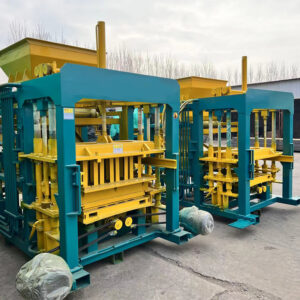
Image source :Aiweiblockmachine
Types of Brick Making Machines
Introduction:
Brick making machines have transformed the construction industry by streamlining the process of brick production. These machines offer increased efficiency, cost-effectiveness, and improved quality control compared to traditional brick-making methods. In this article, we will delve into the various types of brick making machines available in the market today. By understanding their features, advantages, and limitations, readers can make informed decisions when selecting a suitable brick making machine for their projects.
Manual Brick Making Machines
Manual brick making machines are the simplest and most affordable option available. These machines are operated manually, requiring physical effort from the user. They consist of a mold or frame into which the raw material, such as clay or cement, is placed. The user then applies pressure to compress the material, forming the desired shape of the brick. Manual machines are suitable for small-scale brick production and are commonly used in developing countries or areas with limited access to electricity. While they are labor-intensive and slower compared to other types, they offer simplicity and low maintenance requirements.
Semi-Automatic Brick Making Machines
Semi-automatic brick making machines combine manual operation with automated processes. These machines have a higher production capacity compared to manual machines. They typically consist of a feeder, mixer, conveyor belt, and hydraulic system. The raw material is fed into the machine through the feeder, which is then mixed and molded using hydraulic pressure. The bricks are then manually removed from the mold for further processing. Semi-automatic machines provide a balance between cost, production capacity, and automation, making them suitable for small to medium-scale brick production.
Fully Automatic Brick Making Machines
Fully automatic brick making machines are the most advanced and efficient option available. These machines are highly automated, requiring minimal human intervention. They feature a complete set of components and mechanisms that handle all stages of brick production, from raw material feeding to brick stacking. Fully automatic machines often incorporate advanced technologies like computerized controls, sensors, and robotics to optimize the entire process. They offer high production capacity, excellent brick quality, and reduced labor requirements. However, fully automatic machines are more expensive than manual or semi-automatic options, making them suitable for large-scale commercial brick production.
Hydraulic Brick Making Machines
Hydraulic Brick Making Machines
Hydraulic brick making machines utilize hydraulic pressure to mold and shape bricks. These machines are often found in semi-automatic and fully automatic variants. The hydraulic system applies pressure to the raw material, ensuring uniform compression and consistent brick quality. Hydraulic machines offer high productivity, precise brick dimensions, and the ability to produce bricks with complex designs or patterns. They are suitable for producing a wide range of bricks, including solid bricks, hollow bricks, interlocking bricks, and paver blocks.
Clay Brick Making Machines vs. Concrete Brick Making Machines
Another important distinction in brick making machines is whether they are designed for clay brick production or concrete brick production. Clay brick making machines are specifically designed to handle clay-rich raw materials, whereas concrete brick making machines are optimized for cement-based mixtures. Clay brick making machines often employ an extrusion process, where the clay mixture is forced through a die to form bricks. Concrete brick making machines, on the other hand, utilize vibration and hydraulic pressure to shape the cement mixture into bricks.
Hydraulic Brick Making Machines
Hydraulic brick making machines utilize hydraulic pressure to compress the raw material and shape it into bricks. These machines offer high compression force, ensuring consistent density and strength in the bricks produced. Hydraulic systems in these machines are powered by hydraulic cylinders and pumps, which generate the necessary force for molding the material. Hydraulic machines provide precise control over the pressing process, enabling customization of brick shapes and sizes. They are known for producing high-quality bricks with uniformity and accuracy.
Manual Brick Making Machines
Manual brick making machines are the most basic and traditional type of machines used for brick production. They are operated by human power, requiring physical effort to mold and shape the bricks. These machines typically consist of a mold, a lever, and a platform for compressing the raw materials. Manual machines are often preferred for small-scale projects or in areas with limited access to electricity.
Advantages:
- Low cost: Manual machines are usually affordable and require minimal initial investment.
- Simplicity: They are easy to operate and maintain, making them suitable for individuals with limited technical knowledge.
- Versatility: Manual machines can produce different types and sizes of bricks by changing the molds.
- Portability: These machines are lightweight and can be easily transported to different locations.
- Applications:
- Small-scale construction projects, such as houses, farm buildings, and sheds.
- Low-income communities or rural areas with limited resources.
- Hand Press Brick Making Machines
Hand press brick making machines are an upgraded version of manual machines. They eliminate the need for excessive physical exertion by incorporating a lever or a handle for applying pressure to the raw materials. These machines are manually operated but provide higher efficiency and output compared to traditional manual machines.
Conclusion
In conclusion, the types of brick making machines available cater to different needs, production scales, and budgets. Manual machines offer simplicity and affordability but are limited in production capacity. Semi-automatic machines strike a balance between cost and automation, making them suitable for small to medium-scale operations. Fully automatic machines provide high productivity and advanced automation features, making them ideal for large-scale commercial production. Hydraulic systems ensure uniform compression and consistent brick quality. Furthermore
